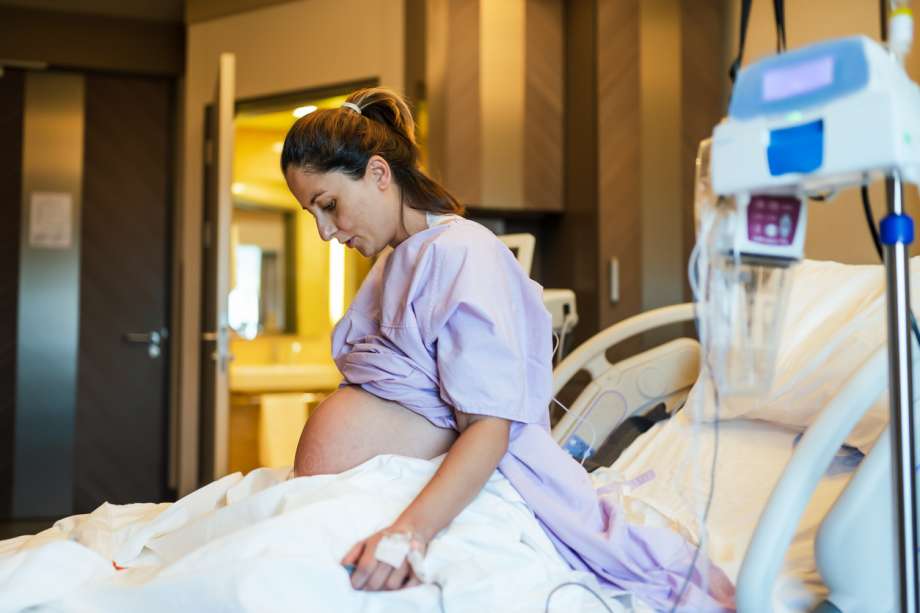Sepsis During Pregnancy: Risks and Treatment for Maternal Sepsis

The leading cause of maternal mortality in the United States is maternal sepsis, especially puerperal sepsis.
Today, maternal sepsis accounts for 13% of maternal deaths and up to 15% of maternal admissions to the intensive care unit (ICU). The cause-specific mortality ratio of maternal sepsis is 2.2 deaths per 100,000 live births.
Anyone who is pregnant or trying to conceive should understand the signs, risks and treatment for maternal sepsis. Rapid recognition of the condition can prevent devastating complications and outcomes.
What is Maternal Sepsis?
Sepsis that occurs during pregnancy, delivery, or the postpartum period is called maternal sepsis. It is a common pregnancy-related condition.
When this condition develops within six weeks of delivery, it is called postpartum sepsis, puerperal sepsis or puerperal fever.
This article discusses the common causes and symptoms of developing sepsis during pregnancy, the risk to both the pregnant patient and fetus and the medical treatment options available for maternal sepsis.
What Causes Maternal Sepsis?
Sepsis, which is often referred to as blood poisoning, is the body’s life-threatening inflammatory response to infection. Although the term sepsis is often used interchangeably with blood poisoning, they are not the same thing.
Blood poisoning or septicemia occurs when bacteria enter the bloodstream which can cause sepsis. However, sepsis does not only affect the blood, it can impact the entire body and cause organ dysfunction.
The cause of maternal sepsis may be due to the pregnancy or something completely unrelated. Some of the causes of maternal sepsis include the following:
Bacterial Infection
Bacteria such as E. coli are the most common infection that caused maternal sepsis for delivery hospitalizations and postpartum readmissions in the U.S.
Mastitis
Infection in one or both breasts can result in sepsis.
Miscarriage
After any miscarriage, there is a risk of infection. This can occur if tissue from the uterine lining was not completely removed and become infected.
Non-sterile Abortion
Abortions that are not conducted in a sterile environment such as outside a hospital or medical facility have a higher risk of maternal sepsis.
It’s crucial to be aware of signs and symptoms of infection following a non-sterile abortion including fever, feeling unwell, abdominal pain, increasing pain and smelly discharge.
Membrane Rupture
The risk of maternal sepsis increases when the duration between when the water breaks to the delivery of the baby becomes longer.
Prolonged or Obstructed Labor
The risk of maternal sepsis increases if the labor is taking longer than expected and it has not progressed.
Potential Cesarean/C-section Side Effects
A Cesarean section is a major abdominal surgical procedure that has associated risks including infection and sepsis.
Other Sepsis-related Risk Factors
Other maternal sepsis risk-factors causes include stillbirth, postpartum hemorrhage, retaining the placenta after giving birth and multiple gestations such as having twins or more.

Some causes of maternal sepsis that are unrelated to the pregnancy include strep throat (group a streptococcus), urinary tract infection, pneumonia and other infectious diseases that increase the risk of sepsis.
What Happens When You Get Sepsis During Pregnancy?
When the body has an infection, it can trigger sepsis. The immune system’s normal response is to send white blood cells to the particular area of the body that is infected. The white blood cells are responsible for eliminating the germs that are causing the infection.
During this response, the tissues become swollen and inflamed to help prevent the infection from traveling to other parts of the body. However, if the infection spreads, widespread inflammation can occur which can decrease blood pressure, harm tissue and limit oxygen from reaching tissues and organs.
Diagnosing Maternal Sepsis
Diagnosis of maternal sepsis can be challenging during pregnancy or after delivery because there are many changes the body undergoes that can mask an infection. For instance, pregnancy and delivery can lead to an increased heart rate, breathing rate and changes in blood pressure. These are the same signs that may indicate an infection.
After giving birth, many people experience heavy sweating, pain, dizziness, lightheadedness and chills. In addition, one of the symptoms of a urinary tract infection (UTI) is using the bathroom frequently.
However, a pregnant patient may not think they have a UTI and credit this symptom to their pregnancy.
Therefore, detecting maternal sepsis early involves being vigilant and aware of its risks, signs and prevention protocols.
Can You Test for Maternal Sepsis?
If a person shows potential signs of sepsis, their doctor will order multiple tests to figure out if there is an infection and the source of infection. For instance, they will do blood tests, and check for high blood pressure, increased heart rate, reduced oxygen saturation level, edema, hypoglycemia and abnormal vaginal discharge.
They may also collect stool or urine samples, wound culture and/or a throat or vaginal swab.
If someone has had a miscarriage, their healthcare provider will do an ultrasound, MRI or CT scan to determine whether there is still tissue left in the uterus.
To determine whether there is a pathogen in your blood, blood tests will be performed to see if there are any of the following indicators:
- Above normal range: lactate levels, plasma C-reactive protein, procalcitonin (PCT), creatinine levels, bilirubin levels, white blood cell count
- Decreased platelet levels
- Presence of immature white blood cells
What are the Symptoms of Maternal Sepsis?

Infections can travel and spread in the body quickly. Therefore, it is crucial to be aware of the symptoms of maternal sepsis. If you experience a few of these signs, contact your healthcare provider immediately for medical assistance.
Some of the symptoms of maternal sepsis include the following:
- Fever over 100.4 degrees
- Chills
- Pain in the lower abdomen and pelvic area
- Tenderness in the uterus
- Dizziness
- Increased breathing rate
- Vaginal bleeding
- Vaginal discharge with a foul odor
- Unexplained drowsiness
- Feeling ill or uncomfortable
- Increased heart rate
- Cramping that lasts longer than 2 weeks
The Sepsis Alliance created the following “It’s about TIME” information acronym to help others remember the important signs of sepsis:
T: Temperature — Higher or lower than normal
I: Infection — May have signs and symptoms of an infection
M: Mental Decline — Confused, sleepy, difficult to rouse
E: Extremely Ill — Severe pain, discomfort, shortness of breath
Can Sepsis During Pregnancy Cause a Miscarriage?
Sepsis during pregnancy can impact the health of the baby; therefore, an earlier delivery may be recommended for the safety of the pregnant woman and baby. To ensure the newborn’s lungs are prepared for an earlier birth, steroid injections would be given to the mother.
General anesthetic would be provided for a c-section but spinal anesthesia or epidural would not be recommended. The baby’s heart rate and the pregnant woman’s vital signs and temperature would be continually monitored during the delivery.
There would be additional monitoring for the baby after delivery as the infection could have spread from the mother to the child during or after birth.
To prevent the infection from traveling to the baby, antibiotics may be given depending on the type of infection.
Risks and Concerns of Maternal Sepsis
Sepsis is highly preventable but it can have a fatal outcome if not detected early. It requires an immediate diagnosis for treatment to work effectively.
Unfortunately, the maternal mortality rate due to sepsis has grown in recent times, increasing 10% from 2000 to 2010 in the US.
Maternal sepsis can increase the risk of preterm delivery, perinatal mortality and low birth weight. For severe sepsis cases that require an ICU admission, the risk of fetal mortality increases to 33%.
Maternal sepsis can affect anyone who is pregnant, delivered a baby, and/or has had a miscarriage or abortion. There are specific factors that put some people at an increased risk of developing maternal sepsis. These risk factors include:
- Those who do not have health insurance
- Those who have a C-section
- Those who have diabetes
- Those who are pregnant with multiple gestations
- Those who undergo invasive tests during pregnancy such as amniocentesis and chorionic villus sampling (CVS)
- Those who undergo invitro fertilization procedures
Can you Treat Sepsis During Pregnancy?

Sepsis during pregnancy is treatable and favorable outcomes depend on early detection and diagnosis. The main goals of treatment include the following:
- Maintenance of tissue perfusion with fluid resuscitation and vasopressor drugs
- Adequate oxygenation
- Control of the infection
- Early antibiotic therapy, corticosteroid infusion and blood transfusion when properly indicated
- Maintenance and monitoring of fetal health
You will be admitted to the hospital where you will be monitored and cared for by a team of medical professionals including those from obstetrics and gynecology, intensivists and anesthetists.
Treating maternal sepsis requires various medications and procedures such as broad-spectrum antibiotics to fight infection. Fluid resuscitation will be performed by giving you vasopressors and IV fluids to raise blood pressure and volume and prevent septic shock and hypotension.
However, this is done with caution due to the risk of pulmonary edema during pregnancy.
You may be given an oxygen mask or a tube and a catheter may be inserted to monitor urine and kidney function.
To identify the type of bacteria that is causing the infection, blood tests will be performed. You will be given an antibiotic that is specific to the type of bacteria identified.
You will be continuously monitored until your condition becomes stable. Your team of healthcare providers will inform you of your prognosis and your development.
How Do I Prevent Sepsis During Pregnancy and After Delivery?
Although it’s not possible to completely remove your risk of developing maternal sepsis, you can reduce your risk substantially by following some preventive practices. Doing so can help prevent infections and reduce the risk of them spreading.
Here are some steps to help you prevent sepsis during pregnancy and after delivery.
- Follow your healthcare provider’s prenatal care advice during your pregnancy
- Ask your healthcare provider about your concerns about sepsis
- Keep up-to-date with your regular vaccinations. These include ones that you have received during your childhood that may require boosters, seasonal flu vaccine and those for travel.
- Limit the number of unnecessary invasive procedures. Ask if there are non-invasive options if your doctor recommends them.
- Ensure birthing and delivery practices are clean and sterile
- Limit the number of vaginal examinations during labor to decrease bacterial exposure
- Request those who are about to examine you to wash their hands first
- If your membranes rupture earlier than expected, contact your medical provider immediately
- After giving birth, be aware of any symptoms of an infection such as a fever, foul-smelling vaginal discharge and increasing and prolonged abdominal pain. Contact your medical provider if you detect any of these signs.
- Follow the care instructions for cleaning and taking care of your vaginal area or c-section incision after childbirth.
Although it is a life-threatening condition with a high incidence, sepsis during pregnancy is preventable and treatable.
Being aware of the signs and symptoms can allow for early detection, diagnosis and effective treatment for a full recovery. If you are pregnant or planning to become pregnant, it is important to ask your doctor or healthcare provider about your risk of sepsis and any questions you may have.

